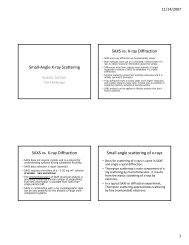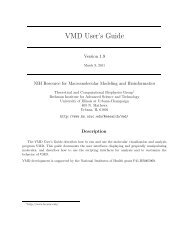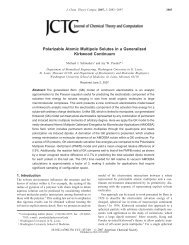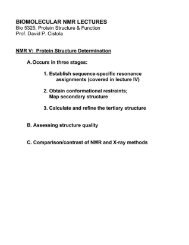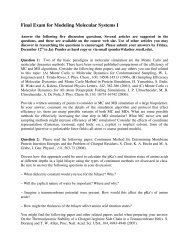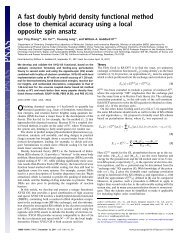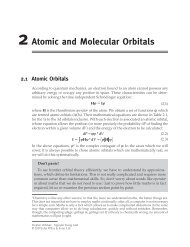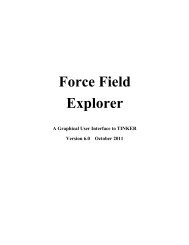What is a ribozyme?
What is a ribozyme?
What is a ribozyme?
You also want an ePaper? Increase the reach of your titles
YUMPU automatically turns print PDFs into web optimized ePapers that Google loves.
The true peptidyl transferase reaction<br />
A2451 forms<br />
hydrogen-bonding<br />
interactions with the<br />
transition-state<br />
analogue<br />
And the site in the ribosome where it occurs
<strong>What</strong> <strong>is</strong> a <strong>ribozyme</strong>?<br />
The ribosome <strong>is</strong> a <strong>ribozyme</strong>; the spliceosome might be a <strong>ribozyme</strong>; RNase P <strong>is</strong> a <strong>ribozyme</strong>;<br />
and then there are small RNAs that cleave themselves that are also <strong>ribozyme</strong>s.<br />
Five nucleolytic <strong>ribozyme</strong>s
Hairpin Ribozyme<br />
Hammerhead Ribozyme<br />
glmS Ribozyme-riboswitch<br />
Hepatit<strong>is</strong> Delta Virus (HDV) Ribozyme<br />
Residues thought<br />
to be part of<br />
general acid/base<br />
catalys<strong>is</strong> are<br />
green/red. Sc<strong>is</strong>sile<br />
phosphate and<br />
2’OH are magenta.<br />
Substrates in light<br />
blue.
In RNase A, the unprotonated H<strong>is</strong>tidine 12 acts<br />
as a general base catalyst, extracting the H from<br />
the 2′ OH, creating a reactive Oxygen that attacks<br />
the phosphate PO 4-<br />
and produces a 2′,3′ cyclic<br />
phosphate.<br />
The protonated H<strong>is</strong>tidine 119 acts as a general<br />
acid and donates its H to the 5′ OCH 2<br />
leaving<br />
group.<br />
The ammonium group of Lys41 stabilizes the<br />
excess negative charge of the trigonal bipyramidal<br />
oxyphosphorane transition-state.<br />
Hairpin, hammerhead, and<br />
glmS <strong>ribozyme</strong>s use the<br />
same acid/base chem<strong>is</strong>try.<br />
Where are the acid and the<br />
base?
H<strong>is</strong>tory of the Hammerhead Ribozyme.
The Hammerhead can be removed from the viral genome and<br />
studied on its own. Uhlenbeck [Nature 1987 328:596] showed that<br />
it could be engineered to become a true enzyme.
Cleavage site
Cleavage rate increases until 50 °C, then decreases. Why?
(except here)
The original HH lacked stabilizing tertiary interactions.
Proposed mechan<strong>is</strong>m for acid/base catalys<strong>is</strong> in the hammerhead self-cleavage reaction.<br />
G12 aromatic N hydrogen bonds to the nucleophilic 2′-OH. G12 <strong>is</strong> invariant in HH <strong>ribozyme</strong>s,<br />
where it serves as the general base in the cleavage reaction. The ribose 2′ OH of G8 makes a<br />
hydrogen bond to the 5′-oxo leaving group (it acts as the general acid).
A schematic pathway of the hammerhead reaction illustrates both how a conformational<br />
transition positions the active site and how it might allow for the reverse ligation reaction. In<br />
the inactive, uncleaved state, a mixture of structures could be present; an even more<br />
heterogeneous mixture could be present in the inactive cleaved state.<br />
If the RNA pers<strong>is</strong>ts for some time (how long?) in its active cleaved state, it could re-ligate<br />
the product since th<strong>is</strong> <strong>is</strong> a reversible transesterification reaction.<br />
If the tertiary interaction <strong>is</strong> too strong, then ligation would also be favored.<br />
If the product:enzyme helix <strong>is</strong> too long, product release would be d<strong>is</strong>-favored and so lead to<br />
ligation.<br />
Th<strong>is</strong> <strong>is</strong> a dynamic process!
Use ensemble measurements to look at the relative orientation of the arms of the<br />
small hammerhead (by lengthening the duplexes)<br />
Mg2+ dependence of the<br />
cleavage rate<br />
Mean d<strong>is</strong>tance and<br />
full width half<br />
maximum (fwhm)<br />
of the arms as a<br />
function of [Mg2+]
Long-range<br />
interactions<br />
control the<br />
rate of<br />
cleavage.<br />
Mutations<br />
(red) d<strong>is</strong>rupt<br />
tertiary<br />
contacts that<br />
reduce the<br />
cleavage rate<br />
via<br />
destabilizing<br />
the structure<br />
around the<br />
sc<strong>is</strong>sile CpG.
D<strong>is</strong>continuous Hammerhead <strong>ribozyme</strong>s have the potential to control gene expression<br />
Martick et al., 2008 Nature 454, 899-902
In the hairpin (A), hammerhead<br />
(B), and glmS (C) <strong>ribozyme</strong>s, the<br />
substrate <strong>is</strong> bound as part of a<br />
deformed helix that docks with<br />
other structures in the enzyme.<br />
The backbone <strong>is</strong> stretched to<br />
align it with residues that cleave it.<br />
In the hairpin (A), G8 and A38<br />
play the part of the h<strong>is</strong>tidines in<br />
RNase A: G8 <strong>is</strong> the base (pKa =<br />
9.0), and A38 the acid (pKa=5.0).<br />
A9 <strong>is</strong> in the position of Lys41<br />
where the exocyclic amines of A9<br />
and A38 provide electrostatic<br />
stabilization of the transition state.
The Hairpin Ribozyme was<br />
d<strong>is</strong>covered in a viroid RNA<br />
where it undergoes selfcleavage<br />
to produce a single<br />
copy of the RNA strand.
Test the chem<strong>is</strong>try of cleavage by NAIM: a modified nucleotide with a phosphorothioate linkage.
A38 cannot serve as the general acid when it <strong>is</strong> replaced by 2F-A or<br />
n 8 A, providing chemical evidence (in contrast to crystal evidence) that it<br />
functions like a h<strong>is</strong>tidine in the cleavage/ligation reaction.
Dynamics of the hairpin <strong>ribozyme</strong><br />
Engineer a three-piece RNA. Tether one strand to glass via biotin/streptavidin.<br />
On one end of the enzyme strand, add a donor and on the other end an acceptor FRET pair.
Single Molecule study of the Hairpin Ribozyme.<br />
dA38 accelerates undocking, since there <strong>is</strong> a loss of a hydrogen bond.
Make mutants in the tertiary interaction and see what happens to cleavage and docking.<br />
S3 <strong>is</strong> a 3-carbon propyl<br />
linker that replaces the<br />
base.<br />
Cleavage activity depends on<br />
rates of docking and<br />
undocking.<br />
The energetics of docking<br />
has contributions from d<strong>is</strong>tal<br />
parts of the structure away<br />
from the active site.
The Hepatit<strong>is</strong><br />
Delta Virus<br />
<strong>ribozyme</strong><br />
requires Mg 2+ for<br />
cleavage.
C75 <strong>is</strong> particularly interesting. It serves as the general acid catalyst in the cleavage reaction. In<br />
the crystal structure of the HDV <strong>ribozyme</strong> in its postcleavage state, C75 <strong>is</strong> proposed to make a<br />
hydrogen bond between its N3 atom and the protonated leaving group, the 5′-hydroxyl of G1.<br />
Th<strong>is</strong> conformation suggested that C75 might be protonated in the reactant state, donate its<br />
proton to the 5′-O leaving group, and thereby serve as a general acid in the cleavage reaction.<br />
Removing the C75 base (creating an abasic site) inactivates HDV, but it can be rescued by<br />
addition of exogenous imidazole!
Another way to look at motion (local motion) of the HDV<br />
active site <strong>is</strong> to use MD simulation*.<br />
In C75+/Mg rev<br />
C75 <strong>is</strong> protonated and the<br />
crystallographically located Mg 2+ ion <strong>is</strong> included in the<br />
starting structure (it <strong>is</strong> thought to act as a Lew<strong>is</strong> acid).<br />
In C75+/noMg, the Mg <strong>is</strong> removed before equilibration.<br />
In C75°/Mg rev<br />
, C75 <strong>is</strong> deprotonated and Mg <strong>is</strong> included in<br />
the starting structure.<br />
The conclusion: Even in these short trajectories, without<br />
the protonated C75, the active site <strong>is</strong> not stable. In<br />
particular, the interaction between C75(N4) and the C22<br />
phosphate oxygen <strong>is</strong> not maintained.<br />
*AMBER99, TIP3P. Hammes-Schiffer group with Bevilacqua
Conclusion:<br />
These are small <strong>ribozyme</strong>s, but they<br />
have evolved different global structures<br />
and sequences. In particular, three of the<br />
four use the same catalytic mechan<strong>is</strong>m<br />
in different active sites.<br />
The chemical contexts of the active sites<br />
allows bases and riboses to act as<br />
general acids/bases, which involves local<br />
changes of the pKa.<br />
The structures flex: the active sites are in<br />
junction regions that are formed by<br />
docking of duplex regions through<br />
tertiary interactions. Docking <strong>is</strong> not<br />
stable, so the conformations fluctuate<br />
between an open inactive form and a<br />
closed active form.<br />
In two of the <strong>ribozyme</strong>s, the reactions<br />
can go forward and backward (cleavage<br />
and ligation), since product release can<br />
be delayed by salt and temperature.<br />
Hammerhead <strong>ribozyme</strong>s appear in all<br />
kingdoms in unexpected places!



